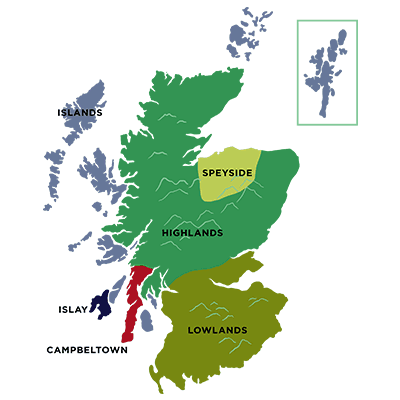The notion of terroir (or the total geographical and environmental influence on a production of a wine or spirit) can often be argued about in Scotch whisky. The Speyside "pear" and the "smoky" Islay are examples of two progiles we often see that arrive from these specific regions.
It should be noted however that when dealing with the uniqueness of single casks as we do with everything we release at The Scotch Malt Whisky Society, terroir becomes a bit more complicated. While our single casks have started their lives at specific distilleries in particular regions, they still often move about. If only from one side of the warehouse to the other, this has an impact on the maturation process and final flavor profile of the whisky inside.
That said, geography still plays a main stage for whisky-lovers, and it's important to know where distinct Scotch whisky styles started and can be found today. Originally defined by four regions (Highlands, Lowlands, Islay, and Campbeltown), today Scotch whisky production is roughly defined by the following six regions.
Lowlands
The southernmost whisky-producing region in Scotland, home to only a few distilleries today including the beloved Auchentoshan, Glenkinchie, and Bladnoch, as well as some notable grains (and other new innovations!) from Girvan. These are lighter-style whiskies that lack significant peat influence and are often on the dryer-side.
Highlands
The largest region producing whisky in Scotland, Highland whiskies are known for their range. From fruity to spicy, Tullibardine, Clynelish, and Glenfarclas are just a few of the distilleries producing beautiful whisky from this vast area.
Islands
Technically an unclassified sub-region of the Highlands, the Islands include all of the whisky-producing islands of Scotland, while excluding The Isle of Islay. Highland Park, Arran, and Jura are just some of the producers on Scotland's beautiful island landscapes; they often exude notes of heather honey, sea brine, and gentle smoke.
Speyside
Speyside is named after the River Spey, the river that runs through the region providing the very important ingredient of water to many local distilleries. Glenlivet, Glen Moray, Longmorn, Mortlach, and Aberlour are some distilleries producing whisky here, often containing sweet, fruity aromas and rich, distinguished mouthfeel. These whiskies often hit all the marks!
Islay
Distinctively peaty, Islay whisky is strong with sea influence. Hard to pick just a few here bur Bowmore, Laphroaig, and Bunnahabhain are some favorite demonstrations to the "love or hate" smokey style coming from The Isle of Islay.
Campbeltown
The elusive Campbeltown whiskies! Not many producers remain here - Springbank and Glen Scotia - to name a couple. Salt, brine and some peat influence make for complex, often savory tasting notes.



